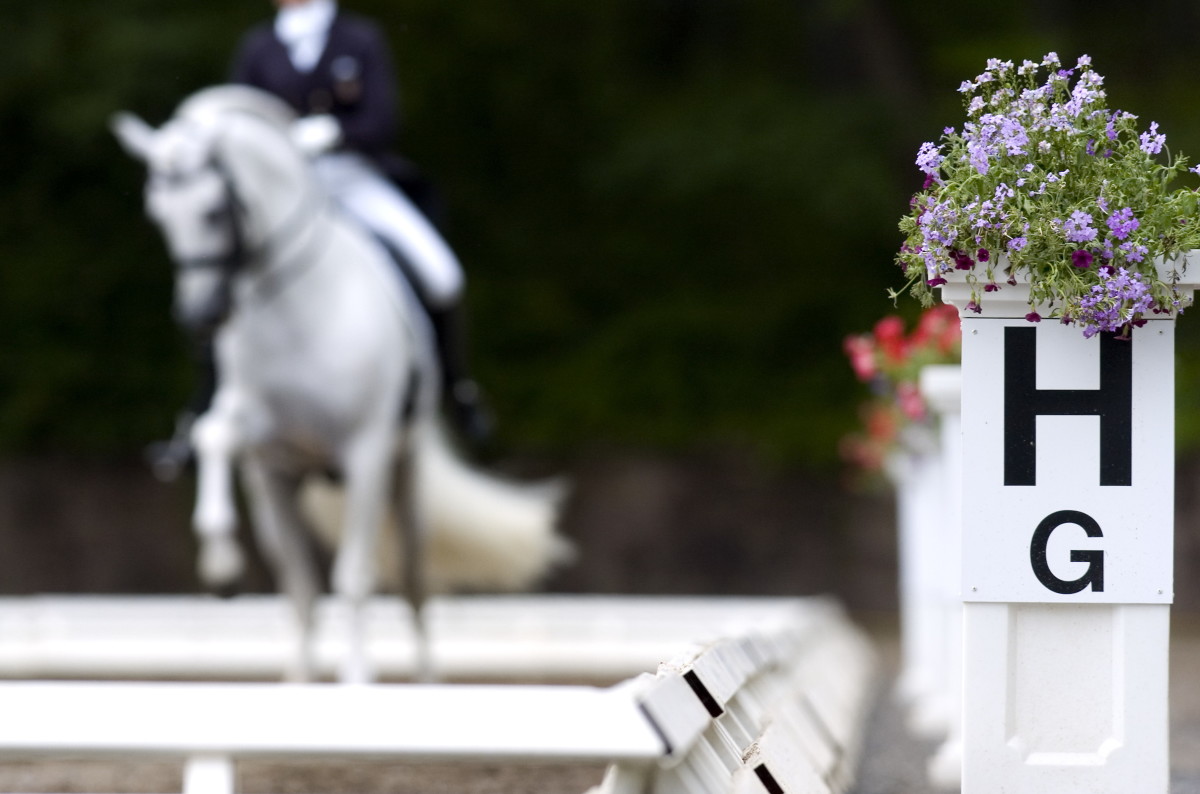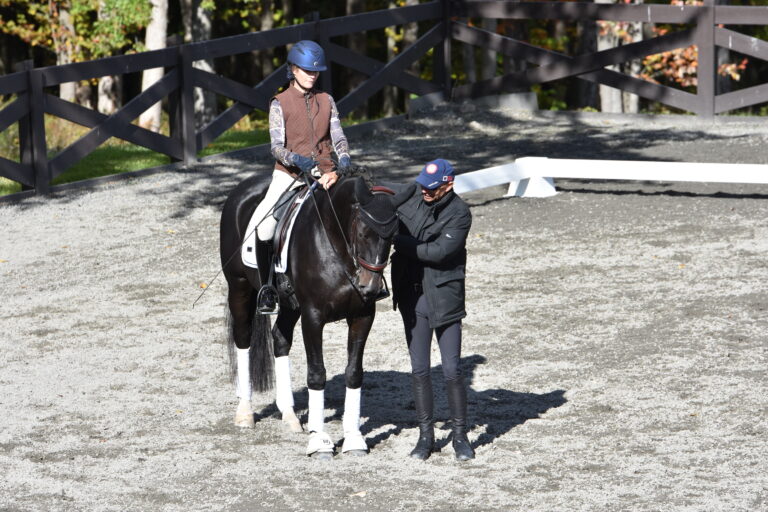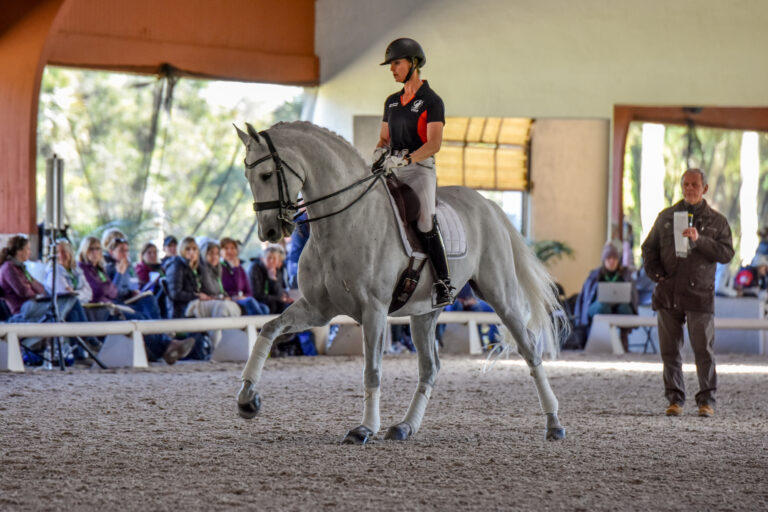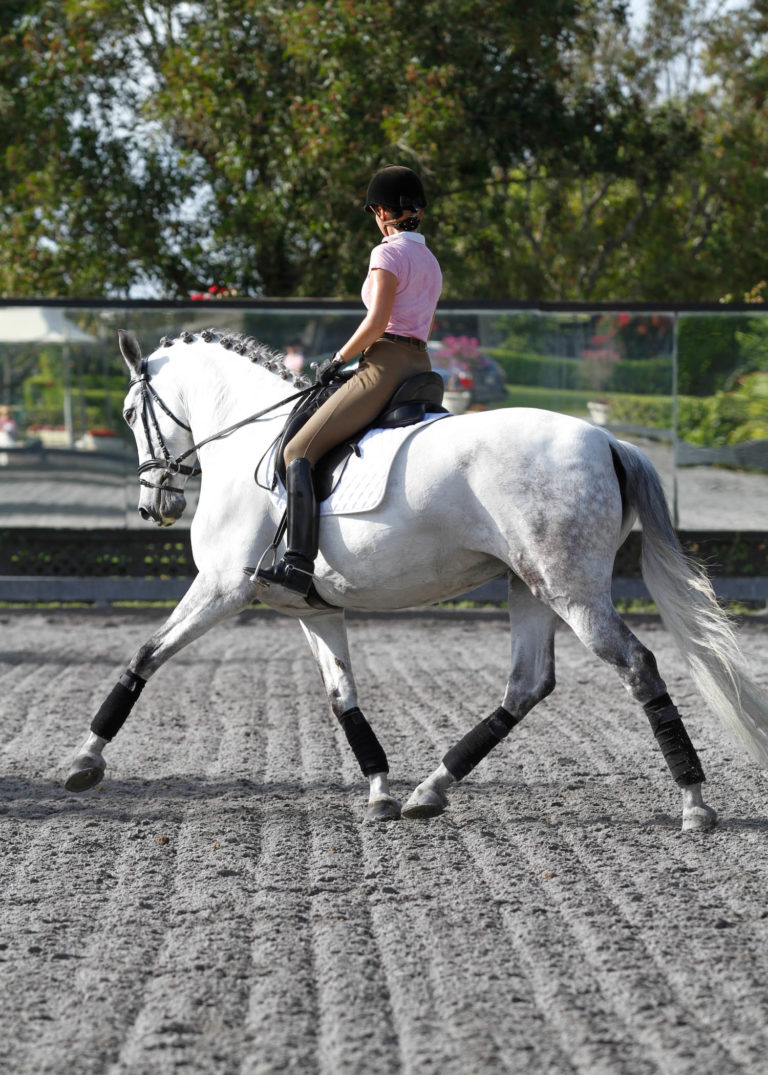As a dressage judge, I see many people riding in the show ring who don’t understand the basic concept of the movement they are trying to perform. I know that sometimes the horse can be difficult and evasive. For example, turn on the haunches: when the rider shows the turns in both directions counter bent, I know she did not read the definition of the movement in the USEF Rule Book. This book is a great source of free information—so please take the time and read about each movement you are schooling or performing at a show.

A Purpose
The movements in dressage all have a purpose. They are there to help improve the horse’s suppleness, his balance and his reaction to your aids. I find that the movements can also help you discover where your horse needs a bit more work. I am a firm believer that if the movement is not going well, just continuing to practice it with the same mistakes over and over again is detrimental to the horse’s training.
If you have a problem in a movement, you, the rider, being the smarter of the two in the partnership, needs to figure out which aid is not working for you. Remember to break down each of the movements and stay true to the Training Pyramid. (There is a lot of detailed information in my book Dressage for the Not-So-Perfect Horse about the aids for each movement and how to discover the most basic cause for the resistance you may be having.) Remember, if the Training Pyramid is correct and your basics are correct, the movement will take care of itself.
Movements and Why You Do Them
These movements stretch the horse, either longitudinally or laterally:
- Leg yield
- Shoulder-in
- Travers and renvers
- Half pass
- Stretch circle
These movements improve the horse’s balance (collecting movements) as well as his reaction to your aids:
- Transitions
- Shoulder-in
- Travers and renvers
- Half pass
These movements test the horse’s adjustability:
- Lengthenings, mediums and extensions
- Transitions between the paces
These movements test the horse’s “sitting” ability (engagement):
- Piaffe
- Canter pirouettes
These movements test the mobility of the shoulders:
- Walk and canter pirouettes
- Turn on the haunches
- Zigzags
Problems and Solutions
Stretch Circle In Trot
The stretch circle in trot is used for the warm-up and cool-down periods of training and is a good test to make sure your horse is adjustable and not rigid in the contact or in a headset. The horse softly chews the reins out of your hands, stretching forward and downward, without losing balance or speeding up. The muscles of the horse’s topline stretch and the suppleness in his back should improve. The contact should be such so that you still have an elastic feel with both reins. The horse should also be able to maintain the bend on the circle and not speed up.
Q: How much contact should you keep or release as you perform the stretch circle?
A: You should have the same contact as you do when your horse is on a shorter rein. You can’t just throw the reins away. Keep using your bending or inside rein to keep him laterally supple and then slowly lengthen the outside rein as he seeks the contact. Think of being able to half halt with a longer rein and you will get the idea.
Q: Can you explain the stretch circle?
A: The stretchy-chewy circle, as I call it, needs to be taught to the horse gradually, not in one day. With a green or young horse, the rider must find a place in the frame where the horse will go 90 percent of the time before trying to change it. The same applies to the tempo of the trot. Once the horse has mastered the idea of stretching equally into both reins, it is time to teach him the bending aids. I find it easier to teach the stretching with his stiff side to the inside. So if the horse doesn’t like to bend left, do the circle on the left rein.
Remember, you are going to use the bending to stretch or lengthen the outside of the body while also asking the horse to stretch and lengthen the topline a bit. Using your bending aids, be sure to push the horse’s rib cage out with your inside leg, then half halt on the outside rein. When the horse lowers his neck a bit, give a little and allow him to lengthen his neck a few inches.
Don’t throw the contact away. The idea is to teach him to go down a few inches more each week. Once the horse has lost the contact, you will have to shorten the reins and start again. Be sure you maintain the bend, otherwise the horse can just curl his neck and drop it rather than honestly stretch into both reins.
Q: In some dressage tests we are told to make a transition between one letter and another. Can you tell me what this means?
A: In the lower-level tests, a rider is asked to make transitions between two letters so it is easier for the horse and rider to accomplish. At the FEI levels, however, a higher standard is expected and transitions need to be prompt—at the letter—and supple.
This really all relates to how well the elasticity of the horse has been developed. At First Level, the horse will not have a lot of difference between his paces. In other words, his lengthenings will be slightly more ground-covering than his working trot. In Grand Prix, however, you have a lot of different trots, all with a different length and height of stride: The piaffe, for example, is the shortest trot; the passage is the trot that comes the most off the ground and the extended trot is the most ground-covering. The Grand Prix horse should be able to shift between these trots smoothly and quickly while the First Level horse has only two gears: working and lengthening, and the transition will take more time at this level.
Q: How much difference in bend should I have between a leg yield and a half pass?
A: If you read the definitions in the USEF Rule Book, you will see that in leg yield there is, in fact, no bend at all. The body of the horse is straight and there is a slight lateral flexion in the poll away from the direction of travel. In half pass, there is a clear bend throughout the entire body of the horse and this bend is in the direction of travel.
Q: In the Equine Canada tests, the 20-meter circle is at A. I was wondering where the approach should be to be accurate (compared to 20-meter circles at E or B).
A: If you are riding in a large dressage arena, you will have the same circle points in the arena. Think of a snowman that has three sections. There is a bottom, a middle and a top. All three sections are the same size and they touch each other. Now think of three circles, exactly the same size, laid down in the 20- by 60-meter dressage arena. These concentric circles are accurate 20-meter circles and also the path that a width-of-the-arena, three-loop serpentine would take. Remember how many meters are between each letter. From the corners to the first letter is 6 meters. Then there are 12 meters between the other letters. So if you used the I and L between the RSVP letters for your circle points, your circles at C and A would be too small and you would be riding a 24-meter oval at B and E.
In a small dressage arena, this, of course, changes as the length of the arena is only 40 meters. So here your 20-meter circles at A and C would touch X. The circle points for your 20-meter circles at B and E would need to be on the centerline, 10 meters on either side of X.
Q: What do you do when a horse shuts down when doing a simple change? He stops, then I wait it out and he finally moves again. Am I doing something wrong? Do I need to be stronger? I always go back and review the walk and the canter.
A: Usually, being stronger is never the answer. I like that you are going back and reviewing the walk and the canter, but it seems to me he has this habit a bit stuck in his brain now. In another question, you mention you are showing Fourth Level, so this is just a training exercise for you, not something you need to do in the test. I think sometimes we, as riders, are too stubborn and perhaps here is a good chance to just go back to something more basic for a while and allow the horse to think more forward.
I would avoid walk–canter transitions for now and do a lot of canter–trot–canter transitions, even perhaps doing a little medium trot between the canter to help his brain think “forward” instead of “stop” as he is doing right now. After a few weeks, you can move on again.
Maybe he doesn’t see the need to do less than a flying change. He sounds like he has an opinion! My suggestion would be to supple him a bit to the left and even leg-yield a stride or two in canter before you ask for the walk. Since he doesn’t want to walk forward, supple and ride him a few strides sideways before asking for the new lead. Think of having a little “renvers-left” feeling before you ask for the new lead as well. This will help keep him connected to the outside (right) rein and hopefully keep him in a better contact.
Q: I have a question about the one-tempi changes. I am new at them, preparing for Intermediaire II. I have the three-tempis down nicely. Getting the two-tempis is difficult! I get excited, then get too busy and, of course, that confuses the issue! Can you help?
A: The two-tempis and the one-tempis can have similar problems. They are basically a series of good single changes. So there are a few tests each day to work on before you start into them. First, make sure you have a good-quality canter with the ability to ride the horse very straight on the quarterline. I also think some simple changes to test this straightness and the new aid for the canter departs should be practiced. Remember, the horse needs to have a quick reaction to the canter-depart aid. Once you have done your homework, do a few one-tempis on the quarterline to help you think about your straightness. If you feel you have to force the aid or throw yourself or your horse around to get it done, then you need to go back and do your homework.
In these series, horses lose their straightness, then also the impulsion, and it is too difficult for them to continue. Don’t be afraid to ride a little more forward in the canter prior to starting the changes and also don’t be afraid to stop asking for the changes when the canter quality falls apart. Just go forward a bit and refresh the canter.
Q: When leg-yielding, I always have too much bend through the body and cause my horse to “pop” his outside shoulder. I see a lot of riders making the same mistake. Any advice?
A: The leg-yield is the second lateral movement we teach the horse. The correct use of leg-yield will teach the horse to move more off the inside leg and over to the outside rein. However, a lot of horses figure out quickly that they can move their weight onto the outside shoulder rather than really increase the lateral suppleness of their body. I suggest you go back to turn on the forehand for a while and teach the horse to keep his outside shoulder more in place with the outside rein and a small amount of counterflexion as you move the hindquarters over. Some work in-hand will help with the correct reaction to this aid, too. Then, when you do your leg-yields, don’t be afraid to counterflex the horse a bit at times to remind him not to push through the shoulders.
Q: I used to ride with hunter/jumper trainers and many were critical of the demands put on dressage horses, saying that at the highest levels many of the movements are unnatural. This seems contradictory to what dressage is about: willingness and fluidity. Can you please comment on this?
A: I would just point out that our dressage athletes are often 17 years old at the Olympic Games and still sound. Good dressage improves the horse’s physique and, therefore, his longevity. I often see dressage movements from foals in the pasture. The only thing I don’t see is a horse doing half-pass or going sideways.
Q: I was hoping to get some insight on a problem that I have been having with my mare. She is a 9-year-old Danish Warmblood, working lightly under saddle, mostly walk and trot. She is really stiff to the left. We have been working on lots of bending and suppling in that direction. Figure eights help. Lately, she has been fishtailing when I ask her to bend left: She swings her butt way out. I try to use my outside leg, but she stops dead and will throw her head all around. I try to reinforce with a whip, but that makes her buck. I am stuck on trying to fix this.
A: Make sure your mare really understands all the bending aids. It sounds as if she understands the inside rein to bend the neck and turn the shoulders, and to move her rib cage away from the inside leg. I am not so certain she understands that the outside leg behind the girth means to keep the haunches in. I would work a bit at walk with head-to-the-wall leg yield and introduce—or reintroduce—the response to the outside leg behind the girth.
Q: Can you tell me what makes a correct half halt?
A: There are actually different half halts for different movements. The weighting of your seat, and which leg is active will tell the horse which movement to expect. The rebalancing half halt is the perfect combination of the driving aids, the bending aids and the outside rein.
Q: How should a rider know if she is ready to show at a certain level?
A: Good question! I think that people say, “I am a Third Level rider,” or “My horse is at Third Level,” just because the horse does a flying change. They don’t realize that the other piece is the horse’s balance: The horse might do flying-changes or even a half-pass, but does he perform with collection and cadence? Is he uphill? Are the basics correct? I often say if the basics are correct, the movements will take care of themselves.
So the correct balance of the horse and the fulfillment of the Training Pyramid (which can be found on the front cover of every USEF Dressage Test under “Purpose”) is of the utmost importance.
A New Freestyle Movement
I always thought ice-skating had it right. When you invented a movement, that movement was named after you. Remember the “Hamill camel” named after Dorothy Hamill? I invented a new movement, too, but was given no credit for it because it was not in freestyle but rather in a regular test.
I have named the movement, “Zigzag at canter with no change of lead.” The judge recognized the difficulty as well and even mentioned it in his comment. The comment read, “High degree of difficulty, but should be ridden in freestyle, not a normal test.”
Here is my story: I cantered perfectly down centerline, ready for the 4–8–8–4. My lovely Trakehner stallion, Maroon, was a bit too smart for his own good and was always clever at invention. I was busy counting, and he was busy ignoring my aids. (Must have been that pretty little filly in Ring 2.)
Well, the counting was perfect as were the bend and the geometry. It was amazing, looking back, how much bend he could have while on the wrong lead and going the wrong direction. Sigh. I think it was all of those suppling exercises I did at counter-canter, bending him the wrong direction and pushing him in a leg-yield sideways to improve the quality of the canter.
Aha! Moment
My “Aha!” moment was when I figured out how to use the dressage movements to train my horse—not just to train my horse to do the movements.
The movements are there to help us create suppleness, collection and engagement. However, the movements can be dangerous without good basics. For example, I see horses that love to go sideways, but the riders cannot ride them on a straight line. This is an incorrect use of lateral work. Also, remember you need to be able to go more sideways or less sideways; in other words, be adjustable and in charge.
FEI “I” and USEF “S” dressage judge and “R” sport horse breed judge Janet Foy has officiated worldwide and is a member of the USEF International High-Performance Dressage Committee. In her newest book, Dressage Q&A with Janet Foy, she attempts to answer all the dressage questions she’s received through the years. In this excerpt, Foy touches on dressage movements—what they are and why they need to be ridden—and answers questions related to various movements. Throughout her new book, including this excerpt, she references her first book, Dressage for the Not-So-Perfect Horse, in which she goes into further detail about how to perform each movement. Used with permission from Trafalgar Square Books.










